Menu
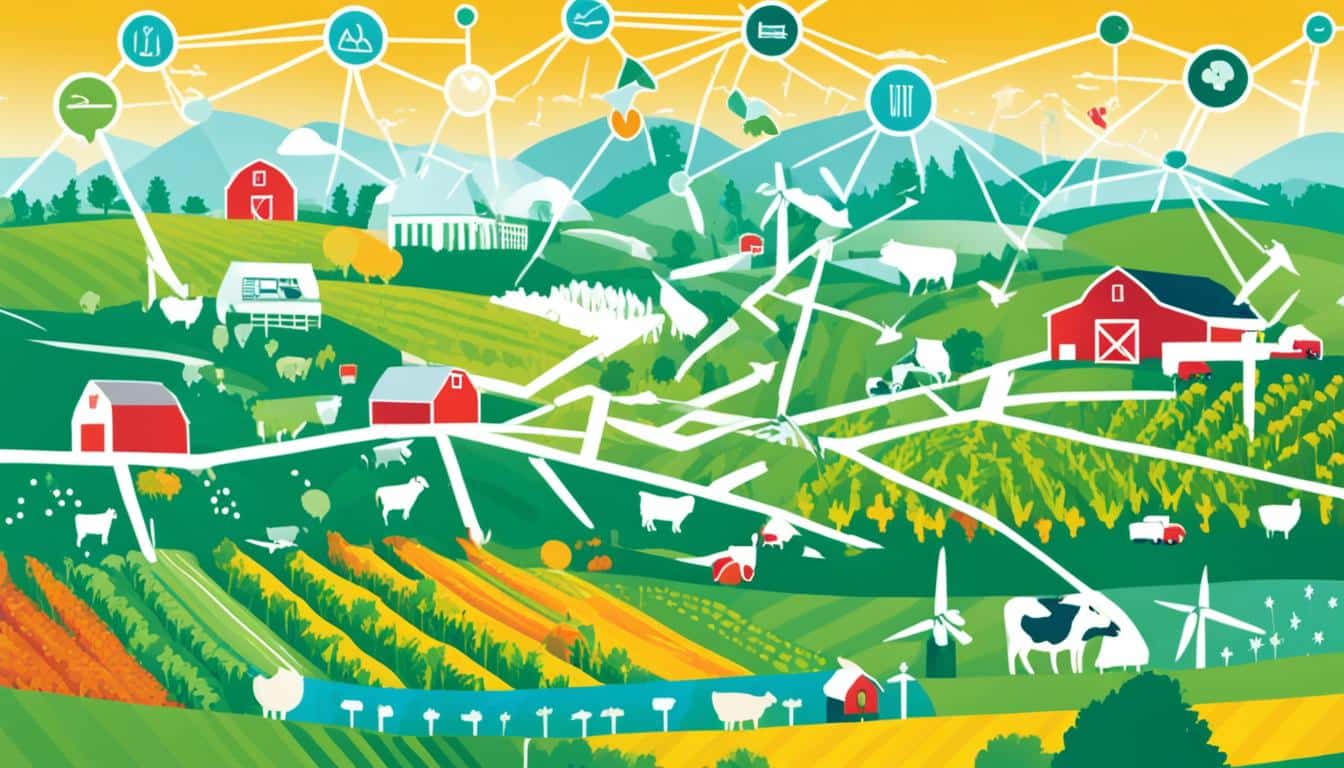
From 2001 to 2016, the U.S. lost 11 million acres of farmable land to other uses. This highlights the pressing need for strong agricultural policies. Good agricultural policies can lead to sustainable farming and help the sector stay strong. They also help make decisions that boost the economy without harming the environment.
Information from various sources like research and expertise shapes a successful agricultural sector. In a study, farmers ranked energy availability in agriculture as most important. But, there are still issues with getting enough energy. This points to a need for better energy infrastructure.
Learning about the many parts of farming rules and policy analysis is crucial. By using various research methods, we gather detailed information. This data helps in the careful and lasting growth of farming.
Agricultural policies are key in shaping the farming sector. They set goals and actions for governments, businesses, and people. Their main aim is to improve sustainability, productivity, food security, and rural life. Knowing about these policies helps us see the detailed rules and plans that keep farming strong.
There are different types of government rules for farming. These show the variety of support that helps agriculture:
Agricultural policies are crucial for many reasons. They help meet farming goals and work on other important issues:
Making big, smart choices and having a solid farming plan are key. This gets everyone behind the policies. Making sure the different farming parts and the money plans all fit together is important. It keeps everything fair and deals with issues that come up among farmers and others involved.
The way we make agricultural policies is complex. It has many steps to meet the changing needs of farming. These steps include working closely with all involved. This makes sure policies are fair and work well. It’s important to know this to make good plans for farming.
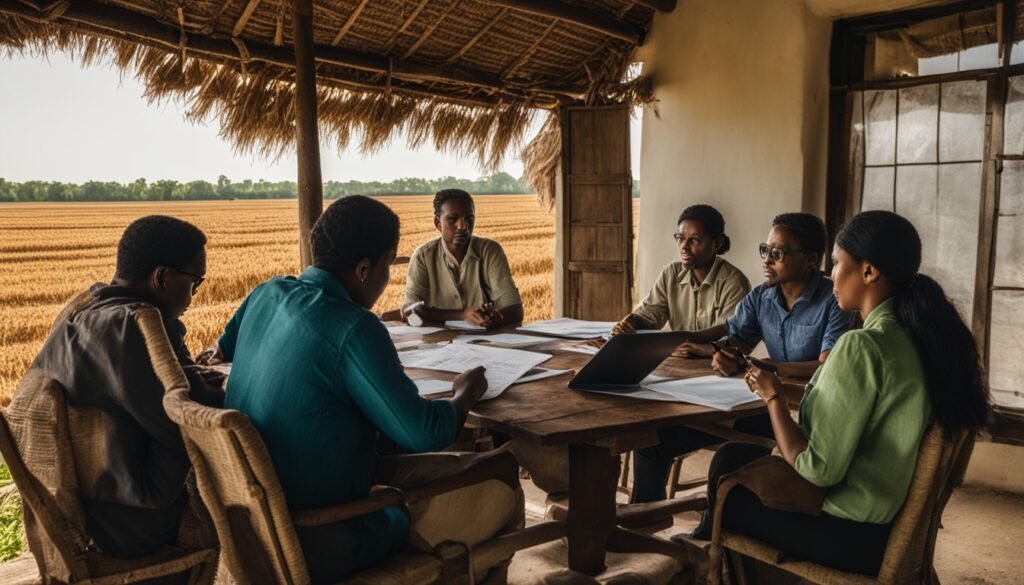
In making agricultural policies, there are four main steps:
Getting everyone involved is key in the agricultural policy formulation process. It includes policymakers, experts, and people in NGOs. Each has an important part to play in policy making.
They all help by:
| Stakeholder | Role | Impact |
|---|---|---|
| Policymakers | Design and start policies | Shape policy decisions |
| Agricultural Extension Officers | Offer hands-on policy advice | Make sure policies work in real life |
| Researchers | Give new insights and solutions | Improve policies with science |
| Non-Governmental Organizations | Fight for community needs and the planet | Make policy-making fair and open |
Together, they create strong policies for farming. Studying agricultural policy frameworks well helps predict and fix problems before they happen.
It’s vital to know about the many agricultural policy goals. They help us meet food needs now and in the future. These aims ensure not just food security but also the health of farming for the long haul. The rational model shows how to set, make, do, and check these goals, step by step.
The key goal is improving food security. This means making sure there’s always enough good food for everyone. We do this by creating strong local food systems and boosting how much food we grow. The policy triangle approach helps put the right plans and people together to make food security better.
Another big goal is to promote sustainable methods in farming policies. These methods protect the earth and help farms deal with climate change. We must put sustainable farming methods into practice. This means using green tech, saving the soil, and managing land well. By using a network approach, everyone who cares about farming can join forces. This makes for better, longer-lasting results.
An agricultural policy’s design is key for its success and impact. It’s crucial to explore the components of these policies. This helps us know their importance better.
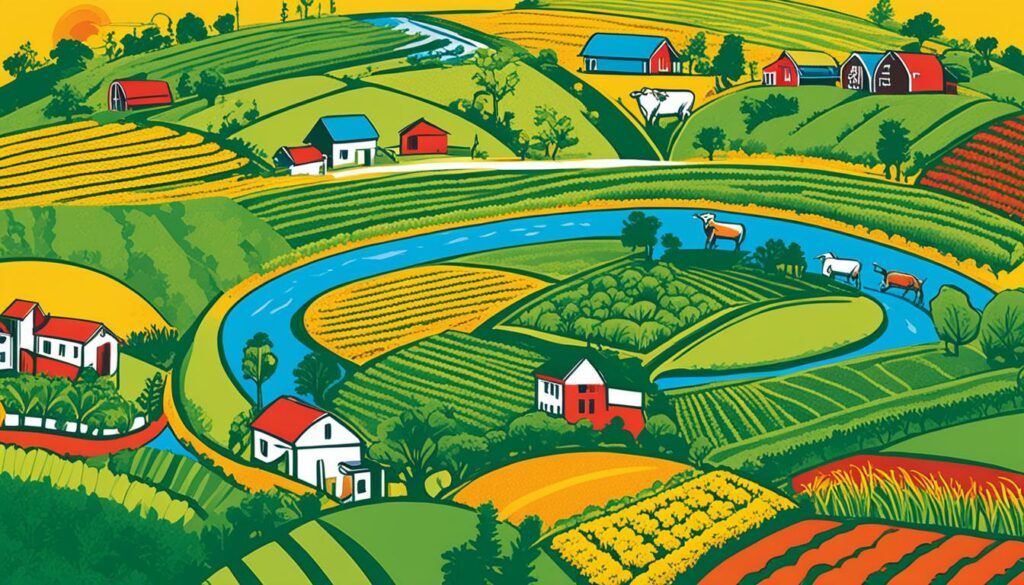
Money in farming is vital for a policy to work well. With more food needed soon, there’s a big demand for farm investments. This is where various ways to finance, like loans and grants, come in. They are key to helping farmers grow their businesses and be stable.
The New Alliance for Food Security and Nutrition helps bring more money into farming in Africa. Along with CAADP, it pushes to spend more of the national budget on farming. This shows how important money strategies are for agricultural growth and food safety.
Creating good ways to produce and sell farm goods is an important part of policy. This ensures products get from the farm to the market well. These ways help add value and deal with trade rules smartly. The rational model and policy triangle also guide the strategies. They look at actors, content, and situation to make plans that work well.
Using sustainable and market-friendly production helps the environment and farming grow. This includes inviting investments that benefit everyone. Such approaches keep farming strong and competitive. With the right policies, we can support a strong and lasting future for farming.
Implementing sustainable agricultural practices is key for long-term farm success and protecting our planet. Research and new ideas are crucial. They lead to the use of improved methods and tools over time.
Research and new ways of thinking are the foundation of *sustainable agricultural practices*. They make farms work better while caring for the environment. A review of almost 18,000 studies showed that methods bringing quick money are picked more often than those helping nature. But, investing in *agricultural innovation impact* leads to great discoveries like managing pests without harmful chemicals and preserving soil, which are key to farming in a way nature loves.
The study pointed out several strategy areas, including solutions for specific problems, and looking after ecosystems and people. Farming folks keep at these methods for the long run because they see positives for their land and community.
Help from experts and those that spread the word is crucial for getting farmers to go green. Out of 577 articles, reviews show that *agricultural extension services* really help in teaching new ways and sharing green practices. They guide and support, helping farmers pick up on the latest tools and methods.
Tying these efforts to making more money pushes farmers to try sustainable ways. Groups like *Sustainable Agriculture Research and Education (SARE)*, by funding and supporting research, show how important a strong *agricultural policy* is. It encourages the success of eco-friendly farming projects.
| Incentive Type | Percentage |
|---|---|
| Technical Solutions | 36% |
| Ecosystem Services | 32% |
| Socioeconomic Benefits | 32% |
Government actions greatly affect farming and agriculture as a whole. They set rules and plans that help ensure farms are both productive and sustainable.
Throughout history, these rules have deeply impacted the farming industry. In 2019, for example, the U.S. had its biggest trade gap in farm goods in 60 years. This shows how crucial agricultural policies are.

In 2023, the focus has been on making certain rules simpler, especially for crops edited genetically.This year, the pork industry has also faced its own struggles. But, the changes have been quick and flexible. Progress like allowing a CO2 pipeline and using drones for farming shows how agriculture is always evolving.
| Region | Policy Impact |
|---|---|
| European Union | Farmers protested against new regulations and cuts to agricultural subsidies. |
| Germany | Lawmakers approved cuts to farmers’ fuel subsidies. |
| Iowa, USA | New cases of High Pathogenic Avian Influenza reported. |
| Somaliland | Over 25 years without a coherent national agricultural policy. |
In 2023, particular attention was given to helping rural America by top government officials. This highlights a push for more farm productivity and greener practices. For instance, the use of advanced farming methods has grown in recent years, shaped by government rules.
Discussions are also in place to update farming laws through the next Farm Bill. This effort showcases a continuous drive to improve the sector. It’s important for different parties, including policy makers, farm groups, and banks, to work together. They aim to create lasting solutions for agricultural success.
Creating good agricultural policies is key to fighting hunger worldwide and promoting farming that lasts. To do this well, we must look at top ways to make policies work and learn from what has been done globally. This knowledge is like a map for understanding and improving the rules that guide farming.
Putting policies into action needs careful planning, getting everyone involved, and checking progress regularly. The OECD’s Investment Framework, made with the help of 60 countries in 2006, is a great model. It got important support by 2013, proving it’s a trusted guide for handling investments in agriculture.
To make farming policies work, keeping an eye on the market and focusing on steady, green growth is vital. The G20, G8, and some countries in development have pushed for more money from private companies to go into farming. Back in July 2009, the G8 asked for more investment in farming to battle hunger. Then, in May 2012, they started the New Alliance. This plan aims to make more private money go to farming in Africa.
Looking at success stories from around the world shows us many ways to make farming laws work. The CAADP programme in Africa set a big goal: a 6% rise in farming every year by 2015. African countries agreed to spend a big part of their budgets on farming and rural areas to help this goal.
In Kenya, the success in farming is clear. Tea exports were worth KES 104.1 billion in 2019. Fresh fruits and vegetables brought in KES 144.6 billion. Meanwhile, meat and other animal products added KES 147.9 billion. These numbers show a strong increase in what Kenya earns from selling its farm products overseas.
| Year | Tea Exports (KES Billion) | Horticultural Crops (KES Billion) | Livestock Products (KES Billion) |
|---|---|---|---|
| 2017 | 134.8 | 115.3 | Not Available |
| 2018 | 134.8 | Not Available | 146.8 |
| 2019 | 104.1 | 144.6 | 147.9 |
Studying these successful cases worldwide can give policymakers smart ideas. By mixing top ways of making policies with strong analysis, we can create farming laws that last and help the planet.
Studying the policy framework in farming shows us its key parts and how to make policies work. With a big need to produce 60% more food in 40 years, we must use smart and green ideas.
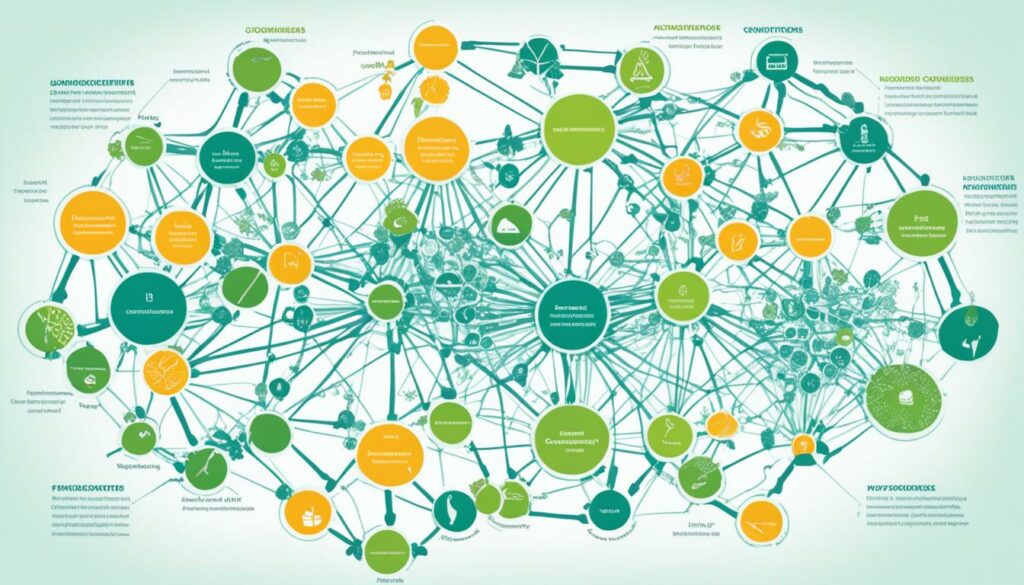
Back in June 2012, the G20’s Agriculture Vice-Ministers said that policies need to help private companies work better. This would help farming grow sustainably and get more connected with markets. The G8 leaders also agreed in 2009, saying more money should go into farming to fight hunger and make the economy stronger.
The Comprehensive Africa Agriculture Development Programme (CAADP) aims to boost farming by 6% each year until 2015. It wants African countries to spend at least 10% of their budgets on farming. By doing this, they hope to get more private money into agriculture.
The Policy Framework for Investment in Agriculture (PFIA) is very important globally. It helps different groups, like governments, companies, and farmers, work together well. Countries like Burkina Faso and Indonesia found it useful to check how well they’re doing in farming.
Helping with money, programs like Canada’s AgriCompetitiveness Program have done a lot of good. They supported projects like making use of waste from mushrooms and making coffee pods that are good for the environment.
Using new digital technologies is also making a big difference. Tools like those for making life better for dairy cows and models to improve rivers show how important innovation is in farming.
In the end, a strong policy plan is crucial. It needs to encourage private money, bring different groups together, and use new ideas. This will lead to a stronger economy and give more people better lives in the farming sector.
The farm sector is vital for many countries, but it faces challenges in policy implementation. To make policies work, we must break through barriers to success. This means dealing with money issues and fixing problems in how farms are run.
Getting everyone to agree on policies can be a big hurdle. Policies need to reflect what all farm groups want to work.
an editorial from Stabroek News
It’s important to talk openly about policies to make them better for everyone. Also, governments should aim for fair rules for all farms, helping them grow, be efficient, fair, and eco-friendly.
Malawi’s government shows strong support by putting 10% of its budget into farming. But, issues with old systems, politics, and team work hold back progress. A fix needs good leaders and all groups in farming to work together.
Money problems really slow down policy work in farming. Many farming areas struggle to get loans or enough money. Some help, like money gifts and tax breaks, have helped a bit. Despite being a big part of Malawi’s economy, farming there still feels the pinch due to lack of funds.
There are also issues with how farms are organised, like not enough staff and no clear rules. These problems need quick fixing. A solid plan that ties policies and money use together could help. This is especially true in places like Rwanda and Ethiopia, where leadership has made a huge difference.
| Country | GDP Contribution | Main Challenges |
|---|---|---|
| Malawi | 44% | Lack of funding, inadequate infrastructure |
| Rwanda | Unknown | Leadership-driven development, policy consistency |
| Ethiopia | Unknown | Leadership-driven development, investment consistency |
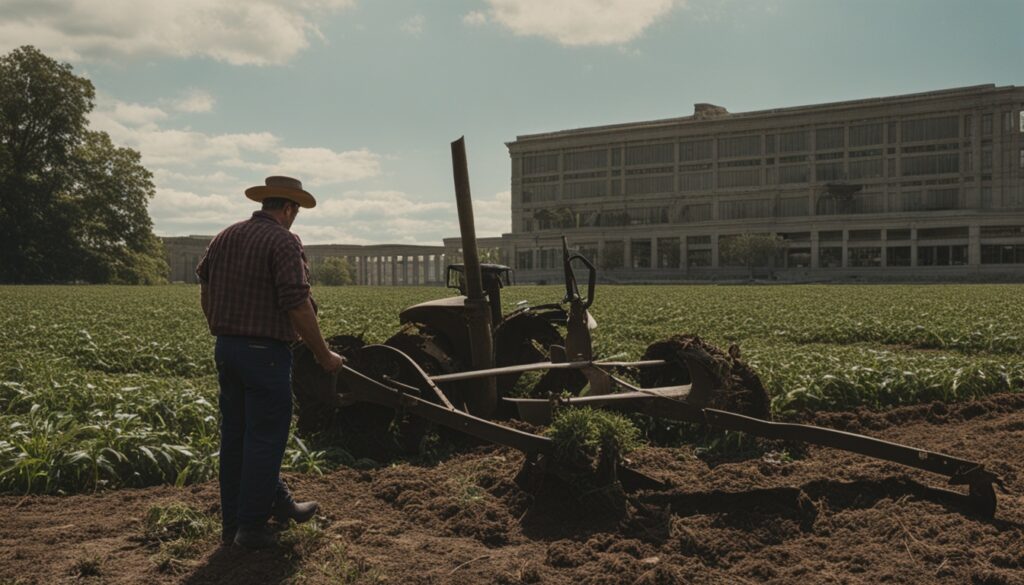
Agricultural laws are critical in how farms look across different places. They tackle economic, environmental, and fair social issues. Looking at how these laws affect farming in various areas helps us see their good and bad sides.
Each place makes laws for farming based on their own needs. Take the 2018 Farm Bill in the United States. It covers many parts of farming and costs about $428 billion over five years. Yet, only a small part of this helps with important things like Local Agriculture Markets.
Here, look at some key points from the 2018 Farm Bill:
| Policy Area | Description |
|---|---|
| Nutritional Assistance | Programs to keep food on the table for the less well off. |
| Conservation | Things to help farming stay good for the earth. |
| Farm Support | Money for farmers to keep prices steady. |
| Research and Innovation | Money to find better and greener ways to farm. |
| Specialty Crops | Help for those who grow fruits, veg, and more. |
Local farming laws greatly affect small farmers. These farmers often have few resources and work on a small scale. They might depend on government help to stay afloat. Laws should support these farmers as they are key to local food and economies.
Big farm-friendly policies could push small farmers aside. This can make life tough for small farmers and lead to economic gaps. So, laws should help all types of farmers do well. This would make farming fairer and stronger for everyone.
Developing plans for agriculture is key for long-lasting success and to tackle immediate issues. These plans help achieve big goals and solve small problems now, leading to overall growth.
In agriculture, looking far ahead and planning is crucial for steady progress and to meet upcoming challenges. The EU’s CAP, for example, plans to spend €387 billion between 2021 and 2027. This money will support farming across Europe, aiming for a stronger future and to feed a growing population.
Bigger groups like the G20 and G8 push for more private cash in farming. They understand how planning is vital to fight hunger and keep economies strong. CAADP focuses on growing African agriculture by 6% each year, showing the power of good strategies.
Working on short-term goals is also crucial for agriculture. Part of the CAP’s budget goes to eco-schemes, rewarding eco-friendly farming. This is to ensure farming remains green and caring for the earth.
Furthermore, part of the CAP’s money aims to support young farmers, making sure farming stays lively and new ideas come forth.
A €450 million yearly fund is also set up to face sudden issues. This highlights the importance of mixing short and long-term strategies in farming policies.
| Funding Allocation | Amount (€ billion) | Purpose |
|---|---|---|
| European Agricultural Guarantee Fund (EAGF) | 291.1 | Guaranteeing agriculture support |
| European Agricultural Fund for Rural Development (EAFRD) | 95.5 | Rural development |
| Horizon Europe Programme | 10 | Research and innovation in agriculture |
| Crisis Reserve | 450 million/year | Tackling future crises |
Combining long-term goals with short-term actions is the best approach for agriculture. It ensures needs are met now while setting the stage for growth. Successful farming policies need a mix of both planning types.
Checking and reviewing agricultural policies is key to making sure they work well. This means keeping a close eye on progress and changing things when needed. The European Commission’s Common Monitoring and Evaluation Framework helps check how well the Common Agricultural Policy (CAP) for 2014-20 worked. Because of a special rule, this checking continues until 2022 to keep things consistent.
It’s really important to keep checking on farm policies. This way, we see what’s going well and what needs to get better. Using certain measures, like how the agricultural sector is doing, helps understand how effective the CAP is. The aim is always to support food production, protect nature, fight climate change, and help areas grow in a balanced way.
Many different tools and methods are used to watch over farm policies. Experts both inside and outside the EU look at how well the CAP is doing in various areas, like farming and protecting the environment. Starting in 2023, new rules will help measure CAP’s success more clearly. These new rules will look closely at different goals and how well policies reach them.
Keeping an eye on agricultural policies shows that people want to be clear and responsible. For example, the U.S. has laws to make sure their government’s work can be checked and improved. Groups like the Food Assistance Division show their work follows important rules. This makes sure their help is as effective as possible.
The policy framework for agriculture guides the way for sustainable farming and supports plans for agricultural development. This framework is key for making sure everyone is working towards the same goals. It also boosts economic growth and sustainability.
There are different kinds of agricultural policies, like those for financing, production, and marketing. They also include rules for extension services. These policies help make agriculture more sustainable, productive, and secure, while developing rural areas.
Formulating agricultural policies goes through many steps. It starts with research, then talking with stakeholders. After that, policies are written and kept up to date. Those involved include policymakers, researchers, extension officers, and NGOs.
The main goals of these policies are to make sure there’s enough food, use sustainable methods, support food security, and help rural areas grow. They’re about meeting people’s nutritional needs while looking after the environment.
The main parts of these frameworks are how to pay for and sell products, and support farmers. They make it easier to get products to market and help those who farm.
Sustainable practices mean farming in ways that last a long time and protect the environment. These methods, with the help of extension services, can really change and improve how well agriculture works.
These policies by the government set the rules, help out with support, and affect how the market works. They aim to meet bigger social and economic goals. Sometimes they also inspire new ideas and changes in the sector.
Good guidelines from around the world can help policymakers and workers in the field. They offer a plan for making policies and strategies that really work.
Making policies work can be hard because of money issues, problems with how it’s structured, and other obstacles. The solution is to have solid plans and keep a good eye on things.
Laws on agriculture can really change how farming happens in different places, especially for small-scale farmers. It’s important that these laws help, not harm, the small farmers’ way of life.
These plans look at the big picture, planning for growth and making sure agriculture can stand the test of time. They also deal with what needs to happen right now. It’s all about finding a balance between what’s needed today and what’s good for the future.
Checking in on how policies are doing is key to keeping them on track and meeting their goals. Using different ways to measure progress helps find out what’s working and what needs to change.